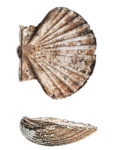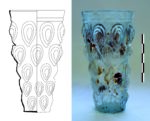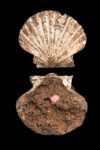 A team of archaeologists has analyzed the contents of a scallop shell found in a 1st c. A.D. grave and found traces of makeup. The scallop shell was discovered in 2000 at an excavation in Mérida, the capital of the Roman province of Lusitania which was founded in 25 B.C. as the veteran colony of Augusta Emerita. The dig unearthed several funerary structures, cremations and inhumations at a site that in Roman times would have been outside the city’s northeast gate on the road to Colonia Metellinensis (modern-day Medellín).
A team of archaeologists has analyzed the contents of a scallop shell found in a 1st c. A.D. grave and found traces of makeup. The scallop shell was discovered in 2000 at an excavation in Mérida, the capital of the Roman province of Lusitania which was founded in 25 B.C. as the veteran colony of Augusta Emerita. The dig unearthed several funerary structures, cremations and inhumations at a site that in Roman times would have been outside the city’s northeast gate on the road to Colonia Metellinensis (modern-day Medellín).
Six burials were excavated. One of them was a rectangular pit dug out of the rock in which the remains of an individual were cremated. Within the pit archaeologists found fill generated by the combustion of the funerary pyre — cremated bone, charcoal and fragments of ceramics, iron nails and tacks from the funeral bed. On top of this layer were grave goods, placed  around the perimeter of the pit after the fire had gone out, including two ceramic vessels of local manufacture dating to the second half of the 1st century, a fine blue glass vase with muscle shell decoration, four small glass unguentaria and a complete Pecten maximus shell, its two halves sealed by a hinge.
around the perimeter of the pit after the fire had gone out, including two ceramic vessels of local manufacture dating to the second half of the 1st century, a fine blue glass vase with muscle shell decoration, four small glass unguentaria and a complete Pecten maximus shell, its two halves sealed by a hinge.
About 4 inches long and wide, both halves of the shell were in good condition. Two holes were pierced through the flat side with matching ones on the convex side. A metallic wire would have been run through them and tied together to keep the shells closed and protect the contents. Inside the scallop was soil that had filled the cinerary pit, a fragment of silver thread and a small oblong ball of bright pink hue distinct against the brown earth.
 That pink ball indicated the scallop shell had been transformed into a pyxis, the ancient Greek name for a vessel, typically cylindrical in shape, used to hold cosmetics. Thus researchers have dubbed it a “bivalve malacological pyxis,” which has now vaulted into the top bracket of my favorite phrases of all time. (In related how-did-I-live-this-long-before-hearing-this news, the two sides of a scallop shell are called valves, hence “bivalves.”)
That pink ball indicated the scallop shell had been transformed into a pyxis, the ancient Greek name for a vessel, typically cylindrical in shape, used to hold cosmetics. Thus researchers have dubbed it a “bivalve malacological pyxis,” which has now vaulted into the top bracket of my favorite phrases of all time. (In related how-did-I-live-this-long-before-hearing-this news, the two sides of a scallop shell are called valves, hence “bivalves.”)
Shells were strongly associated with women going back to prehistory, the shell serving as a metaphor for female sex organ, a metaphor still in active use in numerous languages. There are examples of shells being used to hold cosmetics going back to 2500 B.C. Ur, and the trend continued in the Roman era, with seashells and shell-shaped cosmetic boxes made of amber, bone, glass or precious metals found at sites in Italy and Spain.
Using a combination of X-ray diffraction (XRD), electron microscopy and chromatographic analysis, researchers detected no dyes or mineral pigments (red ocher, vermillion), nor was any mineral substrate in which a dye could have been fixed. It was largely composed of granite lacquer mixed with Rubia tinctorum pigment, color derived from the rose madder plant, and fixed with cold alum. This is an unusual recipe for Roman maquillage, and produces a shade that is much more pink than the orangey-red shades seen in mineral pigments.